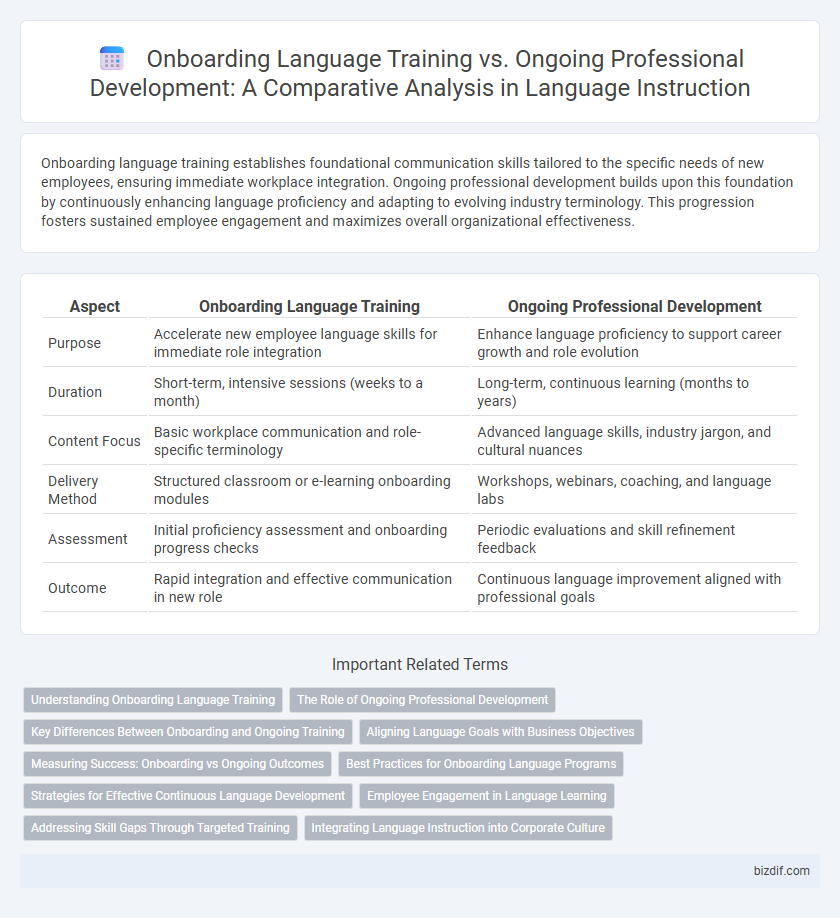Onboarding language training establishes foundational communication skills tailored to the specific needs of new employees, ensuring immediate workplace integration. Ongoing professional development builds upon this foundation by continuously enhancing language proficiency and adapting to evolving industry terminology. This progression fosters sustained employee engagement and maximizes overall organizational effectiveness.
Table of Comparison
| Aspect | Onboarding Language Training | Ongoing Professional Development |
|---|---|---|
| Purpose | Accelerate new employee language skills for immediate role integration | Enhance language proficiency to support career growth and role evolution |
| Duration | Short-term, intensive sessions (weeks to a month) | Long-term, continuous learning (months to years) |
| Content Focus | Basic workplace communication and role-specific terminology | Advanced language skills, industry jargon, and cultural nuances |
| Delivery Method | Structured classroom or e-learning onboarding modules | Workshops, webinars, coaching, and language labs |
| Assessment | Initial proficiency assessment and onboarding progress checks | Periodic evaluations and skill refinement feedback |
| Outcome | Rapid integration and effective communication in new role | Continuous language improvement aligned with professional goals |
Understanding Onboarding Language Training
Onboarding language training equips new employees with essential communication skills tailored to their specific job roles, ensuring smoother integration and productivity from day one. This initial training focuses on fundamental vocabulary, company-specific terminology, and practical language use within workplace contexts. Emphasizing interactive methods and real-world scenarios accelerates comprehension and boosts confidence for effective collaboration.
The Role of Ongoing Professional Development
Ongoing professional development in language instruction plays a crucial role in enhancing teachers' skills and keeping them updated with the latest pedagogical techniques and linguistic research. Continuous training improves educators' ability to address diverse learner needs, integrate technology, and implement effective assessment strategies. This sustained growth fosters higher student engagement and better language acquisition outcomes compared to initial onboarding training alone.
Key Differences Between Onboarding and Ongoing Training
Onboarding language training focuses on equipping new employees with essential language skills tailored to immediate job requirements, ensuring smooth integration and initial communication effectiveness. Ongoing professional development in language training emphasizes continuous skill enhancement, adapting to evolving job roles and industry-specific vocabulary over time. Key differences include the onboarding phase's time-limited, foundational approach versus ongoing training's progressive, adaptive learning to maintain and advance language proficiency in the workplace.
Aligning Language Goals with Business Objectives
Onboarding language training accelerates employee integration by establishing foundational language skills aligned with immediate business needs, enhancing communication and productivity from day one. Ongoing professional development sustains and expands language proficiency, ensuring employees adapt to evolving business objectives and industry-specific terminology. Aligning language goals with organizational strategy maximizes the impact of both onboarding and continuous training, fostering a workforce equipped for global engagement and operational excellence.
Measuring Success: Onboarding vs Ongoing Outcomes
Onboarding language training success is often measured by initial proficiency assessments and the speed of employee integration into communication workflows. Ongoing professional development outcomes focus on continuous improvement metrics such as language retention rates, advanced skill acquisition, and enhanced job performance over time. Tracking learner progress through periodic evaluations and real-world application effectiveness ensures alignment with organizational communication goals.
Best Practices for Onboarding Language Programs
Effective onboarding language training emphasizes immersive, context-rich instruction tailored to new employees' specific roles, enabling immediate practical application and faster integration. Incorporating multimedia resources and interactive modules ensures retention and engagement, while regular assessments track progress and identify areas needing reinforcement. Aligning onboarding language programs with company culture and communication standards fosters consistency and long-term language proficiency essential for professional growth.
Strategies for Effective Continuous Language Development
Onboarding language training establishes foundational skills for new employees, ensuring immediate communication effectiveness and cultural integration. Ongoing professional development employs tailored strategies such as immersive practice, personalized feedback, and advanced language workshops to sustain and enhance proficiency over time. Continuous language development improves workplace collaboration, promotes global business success, and adapts to evolving linguistic demands.
Employee Engagement in Language Learning
Onboarding language training sets the foundation for effective communication by integrating essential language skills during initial employee orientation, enhancing early engagement and confidence. Ongoing professional development sustains and advances language proficiency through continuous, tailored learning opportunities that keep employees motivated and improve workplace collaboration. Prioritizing both stages fosters long-term employee engagement in language learning, driving better performance and cultural integration.
Addressing Skill Gaps Through Targeted Training
Onboarding language training establishes foundational communication skills critical for new employees, accelerating their integration and immediate productivity. Ongoing professional development targets specific skill gaps identified through performance evaluations, enabling continuous language proficiency enhancement aligned with evolving job requirements. Combining both approaches ensures comprehensive language competence, fostering improved workplace collaboration and operational efficiency.
Integrating Language Instruction into Corporate Culture
Onboarding language training establishes foundational communication skills crucial for new employees to engage effectively from day one, while ongoing professional development ensures continuous improvement and adaptation to evolving corporate terminology and practices. Integrating language instruction into corporate culture fosters inclusivity and enhances collaboration across diverse teams, driving productivity and employee engagement. Embedding structured language programs within company values promotes seamless communication and supports long-term organizational growth.
Onboarding language training vs Ongoing professional development Infographic

 bizdif.com
bizdif.com